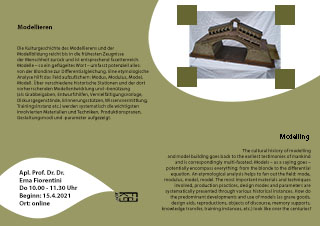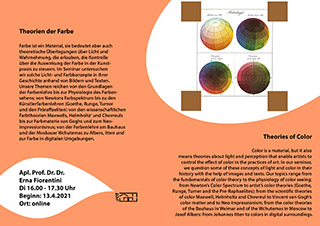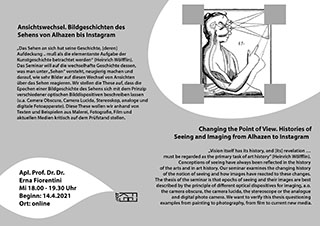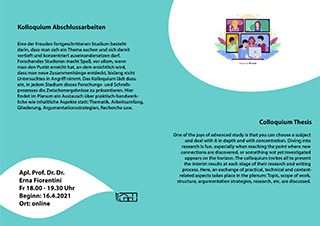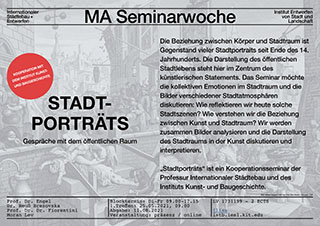Vorlesung: Modellieren | Modelling
Apl. Prof. Dr. Dr. Erna Fiorentini
Donnerstag, 10.00 - 11.30 Uhr
1. Termin: 15.4.2021
Die Veranstaltung findet online statt.
Die Kulturgeschichte des Modellierens und der Modellbildung reicht bis in die frühesten Zeugnisse der Menschheit zurück und ist entsprechend facettenreich. Modelle – so ein geflügeltes Wort – umfasst potenziell alles: von der Blondine zur Differentialgleichung. Eine etymologische Analyse hilft das Feld aufzufächern: Modus, Modulus, Model, Modell. Über verschiedene historische Stationen und der dort vorherrschenden Modellentwicklung und –benützung (als Grabbeigaben, Entwurfshilfen, Vervielfältigungsvorlage, Diskursgegenstände, Erinnerungsstützen, Wissensvermittlung, Trainingsinstanz etc.) werden systematisch die wichtigsten involvierten Materialien und Techniken, Produktionspraxen, Gestaltungsmodi und -parameter aufgezeigt.
The cultural history of modelling and model building goes back to the earliest testimonies of mankind and is correspondingly multi-faceted. Models – as a saying goes – potentially encompass everything: from the blonde to the differential equation. An etymological analysis helps to fan out the field: mode, modulus, model, model. The most important materials and techniques involved, production practices, design modes and parameters are systematically presented through various historical instances. How do the predominant developments and use of models (as grave goods, design aids, reproductions, objects of discourse, memory supports, knowledge transfer, training instances, etc.) look like over the centuries?
Pro-/Hauptseminar: Theorien der Farbe | Theories of Color
Apl. Prof. Dr. Dr. Erna Fiorentini
Dienstag, 16.00 - 17.30 Uhr
1. Termin: 13.4.2021
Die Veranstaltung findet online statt.
Farbe ist ein Material, sie bedeutet aber auch theoretische Überlegungen über Licht und Wahrnehmung, die erlauben, die Kontrolle über die Auswirkung der Farbe in der Kunstpraxis zu steuern. Im Seminar untersuchen wir solche Licht- und Farbkonzepte in ihrer Geschichte anhand von Bildern und Texten. Unsere Themen reichen von den Grundlagen der Farbenlehre bis zur Physiologie des Farbensehens; von Newtons Farbspektrum bis zu den Künstlerfarbenlehren (Goethe, Runge, Turner und den Präraffaeliten) von den wissenschaftlichen Farbtheorien Maxwells, Helmholtz‘ und Chevreuls bis zur Farbmaterie van Goghs und zum Neoimpressionismus; von der Farbenlehre am Bauhaus und der Moskauer Wchutemas zu Albers, Itten und zur Farbe in digitalen Umgebungen.
Color is a material, but it also means theories about light and perception that enable artists to control the effect of color in the practices of art. In our seminar, we question some of these concepts of light and color in their history with the help of images and texts. Our topics range from the fundamentals of color theory to the physiology of color seeing; from Newton’s Color Spectrum to artist’s color theories (Goethe, Runge, Turner and the Pre-Raphaelites); from the scientific theories of color Maxwell, Helmholtz and Chevreul to Vincent van Gogh’s color matter and to Neo-Impressionism; from the color theories of the Bauhaus in Weimar and of the Wchutemas in Moscow to Josef Albers: from Johannes Itten to colors in digital surroundings.
Pro-/Hauptseminar: Ansichtswechsel. Bildgeschichten des Sehens von Alhazen bis Instagram | Changing the Point of View. Histories of Seeing and Imaging from Alhazen to Instagram
Apl. Prof. Dr. Dr. Erna Fiorentini
Mittwoch, 18.00 - 19.30 Uhr
1. Termin: 14.4.2021
Die Veranstaltung findet online statt.
„Das Sehen an sich hat seine Geschichte, [deren] Aufdeckung .. muß als die elementarste Aufgabe der Kunstgeschichte betrachtet werden“ (Heinrich Wölfflin). Das Seminar will auf die wechselhafte Geschichte dessen, was man unter „Sehen“ versteht, neugierig machen und darauf, wie sehr Bilder auf diesen Wechsel von Ansichten über das Sehen reagieren. Wir stellen die These auf, dass die Epochen einer Bildgeschichte des Sehens sich mit dem Prinzip verschiedener optischen Bilddispositiven beschreiben lassen (u.a. Camera Obscura, Camera Lucida, Stereoskop, analoge und digitale Fotoapparate). Diese These wollen wir anhand von Texten und Beispielen aus Malerei, Fotografie, Film und aktuellen Medien kritisch auf dem Prüfstand stellen.
„Vision itself has its history, and [its] revelation … must be regarded as the primary task of art history” (Heinrich Wölfflin). Conceptions of seeing have always been reflected in the history of the arts and in art history. Our seminar examines the changing history of the notion of seeing and how images have reacted to these changes. The thesis of the seminar is that epochs of seeing and their images are best described by the principle of different optical dispositives for imaging, a.o. the camera obscura, the camera lucida, the stereoscope or the analogue and digital photo camera. We want to verify this thesis questioning examples from painting to photography, from film to current new media.
Kolloquium Abschlussarbeiten | Colloquium Thesis
Apl. Prof. Dr. Dr. Erna Fiorentini
Freitag, 18.00 - 19.30 Uhr
1. Termin: 16.4.2021
Die Veranstaltung findet online statt.
Eine der Freuden fortgeschrittenen Studium besteht darin, dass man sich ein Thema suchen und sich damit vertieft und konzentriert auseinandersetzen darf. Forschendes Studieren macht Spaß, vor allem, wenn man den Punkt erreicht hat, an dem ersichtlich wird, dass man neue Zusammenhänge entdeckt, bislang nicht Untersuchtes in Angriff nimmt. Das Kolloquium lädt dazu ein, in jedem Stadium dieses Forschungs- und Schreibprozesses die Zwischenergebnisse zu präsentieren. Hier findet im Plenum ein Austausch über praktisch-handwerkliche wie inhaltliche Aspekte statt: Thematik, Arbeitsumfang, Gliederung, Argumentationsstrategien, Recherche usw.
One of the joys of advanced study is that you can choose a subject and deal with it in depth and with concentration. Diving into research is fun, especially when reaching the point where new connections are discovered, or something not yet investigated appears on the horizon. The colloquium invites all to present the interim results at each stage of their research and writing process. Here, an exchange of practical, technical and content-related aspects takes place in the plenum: Topic, scope of work, structure, argumentation strategies, research, etc. are discussed.
Stadtporträts - Gespräche mit dem öffentlichen Raum
Ein Kooperationsseminar vom IKB – Institut Kunst- und Baugeschichte mit dem ISTB-IESL Institut für Internationalen Städtebau und Entwerfen | City Portrats - Public Space in Conversation
A cooperative seminar of IKB | Institut Kunst- und Baugeschichte and ISTB-IESL | Institut für Internationalen Städtebau und Entwerfen
„Dozent*innen: Dr. Marketa Reuß Brezovska, Apl. Prof. Dr. Dr. Erna Fiorentini, Prof. Dr. Barbara Engel, Moran Lev MA“
Regeltermin: Di – Fr 9:00 – 17:15 Uhr, Geb.11.40, R109 (ISTB) / draußen in KA / im Ilias, Zoom, MS Teams – je nach Situation
1. Treffen: Di 25.05.2020, 9:00 Uhr, Geb.11.40, R109 (ISTB) / draußen in KA / im Ilias, Zoom, MS Teams – je nach Situation
Abgabe/Prüfung: Fr 11.08.2020, 12:00 Uhr, Geb.11.40, R109 (ISTB) / draußen in KA / im Ilias, Zoom, MS Teams – je nach Situation
Teilnehmerzahl: 15 (ISTB) + 15 (IKB)
Die Beziehung zwischen Körper und Stadtraum ist Gegenstand vieler Stadtportraits seit Ende des 14. Jahrhunderts. Die Darstellung des öffentlichen Stadtlebens steht hier im Zentrum des künstlerischen Statements. Das Seminar möchte die kollektiven Emotionen im Stadtraum und die Bilder verschiedener Stadtatmosphären diskutieren: Welche soziale Gruppe nimmt an dem Geschehen teil? Welches kulturelle und soziale Statement wurde dargestellt? Wie reflektieren wir heute solche Stadtszenen? Wie würde man die Szene heute darstellen und wäre sie positioniert? Wie verstehen wir die Beziehung zwischen Kunst und Stadtraum? Im Seminar werden wir zusammen Bilder analysieren und die Darstellung des Stadtraums in der Kunst diskutieren und interpretieren.
The dialogue between the human body and the city is the main theme of many city portraits since the end of the 14th century. The way the public space and public life are pictured reflects a cultural statement regarding the relation between us and the city. The seminar will discuss those collective emotions and their representation as spatial atmosphere: What social and cultural statement are manifested by the artist? How would we present the scene from our perspective? We will analyze the way the representation of public space in art changed through the years and offer new interpretation of the pictured events and a new setting in modern context to further explore the relation between art theory and the urban space.

